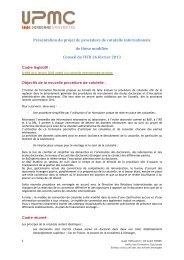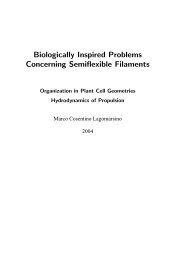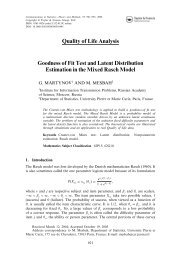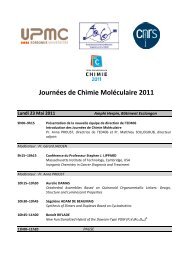résumé (Format PDF) - ED 406 - Université Pierre et Marie CURIE
résumé (Format PDF) - ED 406 - Université Pierre et Marie CURIE
résumé (Format PDF) - ED 406 - Université Pierre et Marie CURIE
Create successful ePaper yourself
Turn your PDF publications into a flip-book with our unique Google optimized e-Paper software.
Journées Bibliographiques de l’<strong>ED</strong>CM<br />
Maurizio PRATO<br />
Chemistry & Nanotechnology: Synthesis and Applications<br />
of Functionalized Carbon Nanotubes<br />
Dipartimento di Scienze Chimiche e Farmaceutiche, Università degli Studi di Trieste,<br />
Piazzale Europa 1, 34127 Trieste, Italy<br />
e-mail: prato@units.it<br />
Among the wide range of novel nanom<strong>et</strong>er scale structures available, single-wall<br />
carbon nanotubes (SWNT) and multi-wall carbon nanotubes (MWNT) stand as unique<br />
materials for fundamental research and potential applications. However, manipulation and<br />
processing of carbon nanotubes (CNTs) has been difficult because of their intractability and<br />
insolubility in most common solvents. Considerable effort has therefore been devoted to the<br />
chemical modification of CNTs, which might open the way to many useful applications.<br />
Our group has been involved in the organic functionalization of various types of nanocarbons,<br />
including carbon nanotubes, nanohorns, fullerenes and nanoonions. The organic<br />
functionalization offers the great advantage of producing soluble and easy-to-handle CNTs.<br />
As a consequence, since biocompatibility of CNT is expected to improve, many<br />
functionalized carbon nanotubes may find useful applications in the field of nanomedicine.<br />
Their use as drug delivery agents and scaffolds for vaccines has already been demonstrated.<br />
CNT functionalized with bioactive moi<strong>et</strong>ies are particularly suited for targ<strong>et</strong>ed drug delivery.<br />
In fact, not only they exhibit reduced toxicity but also possess a high propensity to cross cell<br />
membranes.<br />
Carbon nanotubes can act as active substrates for neuronal growth, a field that has given so<br />
far very exciting results. Nanotubes are compatible with neurons, but especially they play a<br />
very interesting role in interneuron communication. Improved synaptic plasticity is just one<br />
example.<br />
In addition, in combination with polyoxom<strong>et</strong>alate catalysts, carbon nanotubes can serve as<br />
wires for the splitting of water molecules to give oxygen, but, especially, molecular hydrogen,<br />
ideal for clean energy generation.<br />
During this talk, we will illustrate the latest advances in our laboratory of the most exciting<br />
results in these fast developing fields.




![Lingot-12-10-2012-ED.ppt [Mode de compatibilité] - L'UTES](https://img.yumpu.com/50141784/1/190x253/lingot-12-10-2012-edppt-mode-de-compatibilite-lutes.jpg?quality=85)









